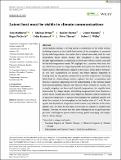Latent heat must be visible in climate communications
Abstract
Anthropogenic forcing is driving energy accumulation in the Earth system, including increases in the sensible heat content of the atmosphere, as measured by dry-bulb temperature—the metric that is almost universally used for communications about climate change. The atmosphere is also moistening, though, representing an accumulation of latent heat, which is partly concealed by dry-bulb temperature trends. We highlight that, consistent with basic theory, latent heat gains are outpacing sensible heat gains over about half of the Earth's surface. The difference is largest in the tropics, where global “hotspots” of total heat accumulation are located, and where regional disparities in heating rates are very poorly represented by dry-bulb temperatures. Including latent heat in climate-change metrics captures this heat accumulation and therefore improves adaptation-relevant understanding of the extreme humid heat and precipitation hazards that threaten these latitudes so acutely. For example, irrigation can lower peak dry-bulb temperatures, but amplify latent heat content by a larger margin, intensifying dangerous heat stress. Based on a review of the research literature, our Perspective therefore calls for routine use of equivalent temperature, a measure that expresses the combined sensible and latent heat content of the atmosphere in the familiar units of °C or K. We recognize that dry-bulb air temperature must remain a key indicator of the atmospheric state, not least for the many sectors that are sensitive to sensible heat transfer. However, we assert here that more widespread use of equivalent temperature could improve process understanding, public messaging, and adaptation to climate change.
Citation
Matthews , T , Byrne , M , Horton , R , Murphy , C , Pielke Sr , R , Raymond , C , Thorne , P & Wilby , R L 2022 , ' Latent heat must be visible in climate communications ' , Wiley Interdisciplinary Reviews: Climate Change , vol. 13 , no. 4 , e779 . https://doi.org/10.1002/wcc.779
Publication
Wiley Interdisciplinary Reviews: Climate Change
Status
Peer reviewed
ISSN
1757-7780Type
Journal article
Description
C.R.'s portion of the work was carried out at the Jet Propulsion Laboratory, California Institute of Technology, under a contract with the National Aeronautics and Space Administration (80NM0018D0004). This work used JASMIN, the UK collaborative data analysis facility.Collections
Items in the St Andrews Research Repository are protected by copyright, with all rights reserved, unless otherwise indicated.

